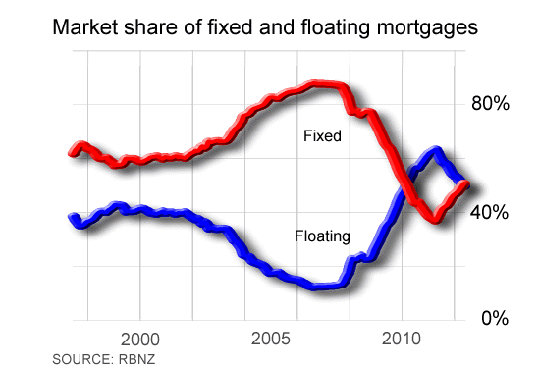
The borrowing rates of Kiwis are continuing to increase, with the annual rate of growth in houshold lending now at its highest level since October 2008.
Total household claims in May - mainly comprising of home mortgages - rose to NZ$195.828 billion from NZ$194.607 billion in April.
The latest figure shows a seasonally adjusted gain of 0.5% - the same as for the past two months, while on an annualised basis the new figure is 5% higher than the figure at the same time a year ago.
The latest figures come just a day after Reserve Bank Deputy Governor Grant Spencer gave a speech in which he said that the the risks to the financial system from the current overheating house market may be actually greater than those posed by the pre-global financial crisis housing boom.
Spencer said that in the central bank's view the strength of housing and credit demand in New Zealand was not being fully reflected in the aggregate credit data.
The figure owed just on mortgages climbed sharply in the past month to NZ$182.661 billion from NZ$181.37 billion. The new figure is 5.3% up on the figure for the same time a year ago. The increase between April and May was the biggest since mid-2007.
Kiwis are continuing to scramble away from floating mortgages to fixed rates with growing signs that the super-low mortgage rates are now disappearing. Fixed rates now make up 50.6% of the total and floating 49.4% - basically a reversal of the positions of the two a month ago.
House prices are now showing signs of strength not seen since the last boom in the early-to-mid-2000s.
And while at the moment the credit growth is not galloping like it did then - with monthly household borrowing figures rising by as much as 1.5%, with 12-monthly rises of over 15% - Kiwis' overall exposure to debt has started this upward property cycle at a much higher level than it did the last housing boom.
Spencer talked up the risks in his latest speech and give further strong indications the RBNZ was looking to indroduce "speed limits" on high loan to valuation lending by the banks sooner rather than later. The high LVR limits are one of the new "macro-prudential tools" being introduced by the RBNZ. See here for our stories on macro-prudential tools.
Agricultural debt is continuing to grow strongly, with the annualised rate of increase now hitting 5.4%, the strongest since early 2010. The total debt level, which hit NZ$50 billion for the first time earlier this year, now stands at NZ$50.763 billion.
Levels of business borrowing continue to be volatile. After a strong jump in debt levels last month there was just a slight gain in May to NZ$79.763 billion, with the annual gain of 1.6% slipping back from 2% in the previous month.
No chart with that title exists.
12 Comments
And while at the moment the credit growth is not galloping like it did then - with monthly household borrowing figures rising by as much as 1.5%, with 12-monthly rises of over 15% - Kiwis' overall exposure to debt has started this upward property cycle at a much higher level than it did the last housing boom.
Opps - the dependence on risky foreign currency borrowing just got away to a month on month increase of 6.12% from NZD 75,613 billion to NZD 80,238 billion. See stats
This must surely mean our banks' loan to deposit ratios have moved up to a level (>140% ave.) that will certainly attract the negative attention of the rating agencies? Read more
Time to scale it back Mr Wheeler, before someone does it for you?
The sophisticated market operators will now work to “distribute” risk to the less sophisticated, a process they expect will be aided by ongoing Fed verbal and QE market support.
The “sophisticated” surely don’t want to be in a situation where they’re fighting the “unsophisticated” to the exits. Read more
Cripes, it seems local carnival barkers have been highjacked to smooth the exit. Read more
He [John Paulson] is making large bets on the US housing market entering a period of sustained rises. He is investing in mortgage insurers on the assumption house prices will increase for some years, meaning there will be few mortgage defaulters. He's also investing in land.
A little caution is adivised as US politicians are aiming to reduce taxpayers liability for insured mortgage payments undertaken by Fed owned Fannie and Freddie. Read more
“The president strongly supports comprehensive housing finance reform that would forever end Fannie Mae and Freddie Mac’s flawed business model that put the American taxpayers on the hook,” Brundage said in an e-mail.
Under the bill, Washington-based Fannie Mae and McLean, Virginia-based Freddie Mac, which package mortgages into securities on which they guarantee 100 percent payment of principal and interest, would be liquidated within five years.
Because the bill would force banks to share the losses from bad mortgages, taxpayers will “know that in the future we won’t have a system where there’s private gains and public losses,” Corker said in the Bloomberg Television interview.
The bill calls for private financiers to hold equity capital of 10 percent of the principal of underlying securities to cover any first loss of the loans. Housing finance participants have been critical of that “first-loss” provision, as it is referred to in the bill, saying it is too big a change from the current system.
Thanks, David.
I wonder if paradoxically New Zealanders' saving has also increased, or whether most of this borrowing is from offshore. It sounds from this that household mortgage debt has increased by ~$9.6 billion in a year; while farm debt has gone up by $2.7 billion, and business debt by $1.7 billion. Maybe another $0.5 billion on non mortgage debt? Separately the government deficit (not the same thing as increase in borrowing, but a proxy for it) is ~$5 billion?
So the increase in debt in total is ~$20 billion, or 10% of GDP. The increase in the current account will be this figure, less any increase in savings by New Zealanders, more or less, as I understand it.
There is always a question whether this increase in debt is demand for debt driven, or supply of loans driven. At a macro level, it seems likely to me that the mortgage increase for just swapping houses in their current state is supply driven. Real improvements, or new houses could be deemed demand driven.
Slow the net capital flows into NZ, or slow the demand for mortgages, and the increase in house prices would slow. And the current account would improve significantly.
A banker told me recently the concerns on farm dairy debt is on farms in the north island. Many people assume it is south Island irrigated conversions, not so, they said.
Croc tears more like.
That will be all the folk struggling to be cash positive, i.e. making trading losses, as we know how long it takes to get over a drought ..... often meaning bankers can slap on an extra risk margin just for good measure.... This current acc. problem we're picking as the home to most of the rise in credit. - growing strongly not the wordfs we'd use...
This is worth a look:
http://www.dairynz.co.nz/file/fileid/46694 ex the ANZ in April.
The average price trend for Fonterra’s notational basket has been US$3,300 per
tonne since 2006.
The issue in Cantab is more capital/asset acc. where operating properties are struggling to sell. - as we mentiuoned earlier, the syndicators are having to make the market themselves....
http://www.stuff.co.nz/business/farming/dairy/8853630/Offer-for-investo…
Interesting links Henry. A syndicate where people have only put in $20,000 sounds like an absolute nightmare to me.
You weren't at SIDE by any chance were you?
Didn't get there, we have hands full since end of May.....
Not Nothing: Did you see this:
Taupo farmer Mike Barton on the realities of farming under a nutrient capThe science needs of a nitrogen-capped farmer (PDF, 774KB)
the you tube is there too:
http://www.beeflambnz.com/news-events/News/2013/june/multimedia-farmer-…
Yes. Mike was a Keynote Speaker and I attended the workshop he and Sue Yerex ran. I see these Taupo farmers an pdk's house having similarities - fine on an individual basis, but can't be extrapolated out to the wider community/industry. Was interesting that Mike bought his farm in 2004 - four years after the process was started.
As a farmer in the Waituna I felt that there is not a lot of similarity between our experience and that of those Taupo farmers.
- Yes they are farming under a N cap but when asked what they consider a % majority of landholders as a mandate to accept solutions '51% is a majority' was the reply. Compare that to the Waituna Drainage Committee being hesitant to accept a mandate of 60% for a not insignificant levy-they want their mandate to be around 75-80%, which I believe in time they will get.
- Government compensated $81m which Mike believes won't ever happen again.
- They can trade N units which they warned about and don't see necessarily that as a solution for all. Dairy Holdings was able to buy and convert two dairy farms through buying N units.
- Taupo story was 4 dairy farms and >100 sheep farms. Waituna percentage of ag land use 60/40 in favour of sheep, though each year we seem to see a dairy conversion being done by existing sheep farmers.
- They levied per stock unit for research/science funding, with the Maori Land Corporations being the biggest funders. Waituna has the Waituna Technical Group - scientists from all stakeholders ES, DairyNZ, DoC etc all working together. DairyNZ funds approx $1.2m per year for science in Southland. Some is in collaborative projects, some not. Beef and Lamb is supportive of efforts, but doesn't have the funds to fund science.
- They seem to pin their future on Taupo Beef branding, which is only sold to local restaurants. Yet they want to see a bigger premium paid to those farmers - so a long term sustainability issue?
- Good on them for continuing to farm under the cap. But IMO there are some very special circumstances around that deal and it has only being operating for two years.
There were quite a few interesting SIDE workshops on nutrients/environment - the reason we went. Interesting stuff on Overseer which you have alluded to on another thread. Professor David Hughes was an entertaining chap with an interesting message. Was good to chat to him after his workshop too. http://www.profdavidhughes.com/
Horizons One Plan and Otago Regional Council N Caps also came in for mention at various workshops.
And is it to build better prospects for NZ's future?, no just the usual, to pay way too much to buy houses.


We welcome your comments below. If you are not already registered, please register to comment
Remember we welcome robust, respectful and insightful debate. We don't welcome abusive or defamatory comments and will de-register those repeatedly making such comments. Our current comment policy is here.